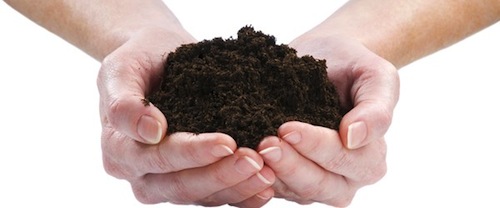Container Gardening: Soil Preparation
Preparing the soil that goes into your container is critical for the health of the plants that will grow there. Don't assume that using dirt from the ground is going to work; container soil has some special requirements.Container Soil Requirements
Regulating the moisture levels in a container is critical; too much or too little moisture is bad news for plants. The soil you use in your container needs to be well-aerated and drain easily , but still be able to maintain adequate moisture for plant growth. It's a 'goldilocks' situation; moisture levels need to be just right.
It's not recommended to simply dig soil out of the ground and put it in the container, even if it's healthy-looking and produces healthy plants. The walls of a container are very constricting and restricting to dirt that comes directly from the ground, and that severely limits aeration and drainage.
Modifying Soil for Container Gardening
Regular garden soil doesn't offer enough moisture, air, and nutrients for plants to thrive. As mentioned above, container soil needs to drain well AND hold adequate moisture.
In the ground, excessive moisture can simply drain deeper into the ground below the root level of the plants. In a container, even with drainage holes, excess moisture pools up at the bottom. If the soil contains smaller "pores" or air pockets, this moisture builds up quicker. This is bad for the plant's roots. Larger pores in the soil allow this moisture to drain more efficiently through the bottom of the container, and allow more air (oxygen) to fill in the space. This air is just as important to the plant as the water. This fluffy, airy soil is created by mixing mineral aggregates into the container soil.
The most commonly used mineral aggregates for container soil are perlite, vermiculite, sand, and calcined clay (commonly sold as kitty litter). Vermiculate and perlite are natural volcanic rock materials that are naturally full of pockets for aeration. Perlite doesn't break down, and will hold its aeration qualities for longer periods of time. Vermiculite material, on the other hand, can add beneficial nutrients such as potassium and magnesium as it breaks down and leaches into the soil.
In addition to providing aeration, a container soil must be able to hold moisture. By adding organic materials to the soil, such as peat or sphagnum moss, the soil will be able to remain moist for longer periods of time. Water clings to these organic materials at the same time the mineral aggregates are draining it away; this balance of drainage and moisture control is exactly what the container soil needs.
Some commercial potting soils also contain sawdust or shredded bark to help maintain proper moisture. Limecan be added to the soil to balance the organic material's acidity, and fertilizer can be added to increase nutrient levels. It's important to follow any fertilizer directions to avoid over-fertilizing.
Make Your Own Container Soil
Commercial container soils are available that contain some or all of the materials mentioned above that can be used with confidence. Gardeners wishing to make their own container soil (which is usually much cheaper to do) can mix perlite or vermiculite with peat or sphagnum moss. These are all readily available materials; other natural organic materials that can be used are leaf mold and compost, which add beneficial nutrients.
Nutrient deficiencies and ph imbalances can be controlled by adding small amounts of ground soil to the container soil mix.
comments powered by Disqus




































































